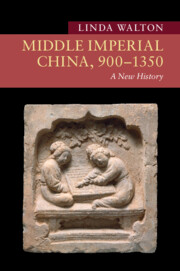Book contents
- Middle Imperial China, 900–1350
- New Approaches to Asian History
- Middle Imperial China, 900–1350
- Copyright page
- Dedication
- Contents
- Figures
- Maps
- Acknowledgments
- Introduction
- 1 The Turbulent Tenth Century
- 2 Song in a Multipolar World
- 3 Schooling, State, and Society in Song and Jin
- 4 An Economic Revolution?
- 5 Cities and Urban Life
- 6 Religious Transformations
- 7 Ways of Knowing
- 8 The Arts of Culture
- 9 Gendered and Generational Lives
- 10 Mapping the Built and Natural Environment
- 11 Sustaining Life and Healing Bodies
- 12 The Mongol Yuan Dynasty in China
- 13 Yuan China in the Mongol Eurasian Empire
- Bibliography
- Index
- New Approaches to Asian History
5 - Cities and Urban Life
Published online by Cambridge University Press: 20 July 2023
- Middle Imperial China, 900–1350
- New Approaches to Asian History
- Middle Imperial China, 900–1350
- Copyright page
- Dedication
- Contents
- Figures
- Maps
- Acknowledgments
- Introduction
- 1 The Turbulent Tenth Century
- 2 Song in a Multipolar World
- 3 Schooling, State, and Society in Song and Jin
- 4 An Economic Revolution?
- 5 Cities and Urban Life
- 6 Religious Transformations
- 7 Ways of Knowing
- 8 The Arts of Culture
- 9 Gendered and Generational Lives
- 10 Mapping the Built and Natural Environment
- 11 Sustaining Life and Healing Bodies
- 12 The Mongol Yuan Dynasty in China
- 13 Yuan China in the Mongol Eurasian Empire
- Bibliography
- Index
- New Approaches to Asian History
Summary
Cities that rose up around trade differed significantly from those built as political and ceremonial centers, as the earliest cities in China were. Cities that grew as centers of trade showcased the expansion of commerce and the maritime connections that helped to fuel the Song economic revolution. Commerce drove urbanization during the Northern Song as both domestic and foreign trade increased dramatically. The population of the Northern Song capital, Kaifeng, grew to around a million, and port cities such as Quanzhou along the southeast coast made room for communities of foreign merchants along with their native residents. Both literary accounts such as Memories of the Eastern Capital and the unique visual representation of city life in Spring Festival along the River richly portray diverse aspects of Song urban life: order and disorder, festivals and entertainment, access to goods and services, food supply and distribution, intermingling of different social classes and genders. The Khitan Liao, Tangut Xi Xia, and Jurchen Jin also established multiple capital cities as they formed centralized states and empires. In part these were modeled on Chinese cities, but archaeological and other evidence has shown that cities often served quite different purposes for nomadic pastoral peoples.
Keywords
- Type
- Chapter
- Information
- Middle Imperial China, 900–1350A New History, pp. 120 - 142Publisher: Cambridge University PressPrint publication year: 2023

